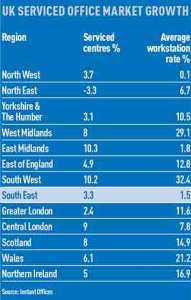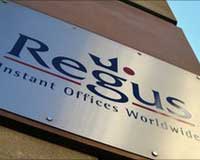 The UK’s serviced office sector has enjoyed significant growth in recent times. As confidence returns to the market and demand grows for fixed-cost, flexible office space, the serviced market is keen to capitalise.
The UK’s serviced office sector has enjoyed significant growth in recent times. As confidence returns to the market and demand grows for fixed-cost, flexible office space, the serviced market is keen to capitalise.
According to broker Instant Offices, the number of serviced offices across England rose by 3.6% in 2014, in addition to an 11.4% increase in desk rates.
However, according to its latest research, the South East stands out from the crowd as the worst-performing region. The number of serviced centres fell by 3.3%, while workstation rates rose by a mere 1.5%.
Instant’s John Williams says the disappointing figures are partly down to the allure of its regional neighbour.
He says: “The gravitational pull of London is bound to have had an effect on the surrounding area.”
Greater London now accommodates 30% of the national serviced offices market. Central London, the City, West End and South Bank have all seen double-digit serviced office centre growth, while the capital as a whole achieved a 20% hike in workstation rates.
Given the returns to be had, London has been a magnet for operators with money to spend, to the detriment of the Home Counties.
“Start-up tech occupiers are also drawn to London because that’s where all the investment is,” says Louize Clarke, co-founder of ConnectTVT.
 ConnectTVT opened on Oxford Properties’ Green Park in February, offering serviced space and facilities for innovative start-ups. Clarke says: “One of the problems is that while so much money is spent on areas like Shoreditch, the South East struggles to compete as a place for businesses to locate. From a tech perspective, it seems to have disappeared off the cluster map.”
ConnectTVT opened on Oxford Properties’ Green Park in February, offering serviced space and facilities for innovative start-ups. Clarke says: “One of the problems is that while so much money is spent on areas like Shoreditch, the South East struggles to compete as a place for businesses to locate. From a tech perspective, it seems to have disappeared off the cluster map.”
Yet London’s attractiveness only partly explains the comparatively poor performance of the South East market. Agents and operators alike insist demand for serviced space is generally strong – the problem is accommodating it.
Brighton, for instance, saw no new serviced office centres open in 2014, according to Instant, while its average workstation rate fell by 31.1%. According to Williams, the city has seen significant investment in recent years and it is taking time for demand to catch up.
“That’s not a picture we recognise,” says Brighton-based agent Ed Deslandes of Flude Commercial. “Demand for serviced space is strong, fuelled by the likes of digital media, marketing and software companies.”
He adds: “Existing operators all seem to be doing well and many want more space. Yet there’s very little stock and
as demand grows from conventional office occupiers, operators are struggling to grow.”
According to agent Stiles Harold Williams, Brighton has only around 300,000 sq ft of office space available, very little of which is grade-A stock. Serviced office operators are no longer able to rely on soft deals offered by landlords looking to avoid empty rates during the recession, and are finding it increasingly difficult to expand.
Brighton Media Centre, for instance, operates five serviced centres across Brighton and Hove. “We’re full and have a waiting list,” says founder Ian Elwick. “We would like to expand but there isn’t the space to do so.”
It is a similar picture in Oxford. The Instant figures indicate the number of centres dropped by 8.3% last year, while workstation rates fell by 11.6%.
“Demand from innovative businesses is high and operators are keen to locate in the city centre, but space is so constrained,” says Richard Venables, director at Oxford agent VSL.
He adds: “When we let space at the town hall to Oxford Innovations, it was fiercely fought over by a whole group of serviced office operators wanting to come in. Unfortunately, it will be another three years before new stock is available.”
Such constraints are preventing the serviced office market from fulfilling its potential across the region.
According to Instant, Cambridge saw exponential growth during 2014, but the market is being prevented from expanding further due to a lack of affordable opportunities.
Savills’ Guy Baker says: “As the market has picked up, so has competition for space. We’ve seen office rents go from the high teens to £35 per sq ft in the past five years.”
Mantle Estates operates serviced office centres in Stansted, Chelmsford, Cambridge and Duxford and hopes to expand to around 20 centres in the next five years. Director Guy Baker says: “We opened the second floor of our Cambridge centre in July 2014 and by September it was full.”
He adds: “Serviced office operators have reasonably prescriptive requirements and some towns just don’t have the space they need. Added to that, rents are increasing and operators have major upfront costs. You need sufficient resources to weather the storm.”
As choice diminishes and costs escalate, returns are failing to stay abreast. “Workstation rates across the Thames Valley range from £300 to £550 and they’re just not where they need to be to keep pace with rising occupational costs,” says Peter Barrett of Reading-based agent JJM Barrett Associates.
He adds: “In central Reading, for instance, office rents now stand at £35 per sq ft. Workstation rates are lagging behind at £300 to £350. Operators would like to invest, but rates need to get towards £500 to make that viable.”
The scenario is frustrating for successful operators with an appetite to expand their portfolio. United Business Centres operates 10 serviced office centres across the country and aims to push that number up to 30 in the near future.
“We’d like to open one a quarter and are looking right across the South East because we believe it offers real growth opportunity,” says UBC’s property and acquisitions director, Richard Johnson.
The group recently opened a 17,500 sq ft centre in Fleet, Hampshire, but has so far been unable to secure any further opportunities.
“Landlords are pushing up rents all the time in South East towns where supply is often tight,” says Johnson. “Incentives have come in and they want hefty deposits. When we come to do our calculations around financial viability, the occupational costs for 99% of buildings are just too high.”
He adds: “Workstation rates will eventually catch up to those in other parts of the country, but it is taking time. That’s partly because operators are conscious of Regus’s appetite. They are nervous about pushing rates up when they know Regus can afford to hold them where they are.”
Regus: Onwards and upwards
 Regus plans to open up to 30 centres across the South East in the next 18 months, asserting its dominance in the serviced office sector.
Regus plans to open up to 30 centres across the South East in the next 18 months, asserting its dominance in the serviced office sector.
The operator already has more than 75 centres across the region and, despite rising rents and diminishing stock, is ready to invest in an ambitious expansion programme.
“We’ve seen strong occupation due to growing demand for flexible space,” says Regus UK chief executive Richard Morris. “The centres will range in size and type according to the opportunities in the local market.”
Morris estimates that two-thirds of the centres will be in locations new to Regus. He is particularly attracted to affluent areas with a high proportion of sole traders and entrepreneurs. Locations will not be announced until the summer, but Morris says that the list will include Ashford in Kent and Welwyn Garden City in Hertfordshire.
He concedes that office supply across the region has tightened in recent months, but is confident deals can be done. “If we have to pay higher rents, we will, because we are confident we can make it work,” says Morris.
He claims that, excluding central London, Regus workstation rates have risen by an average of around 15% in the past year. Across the South East in particular, he believes they would need to rise a further 15-20% in the coming 12 to 18 months in order to take them to their pre-recession level.
He adds: “London is approaching, if not at, the top of the cycle in terms of rents. The South East can offer locations with growing populations and employment, such as Milton Keynes and High Wycombe, which may be more attractive alternatives.”










